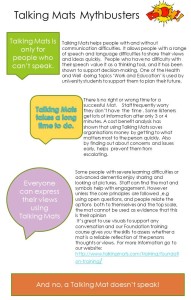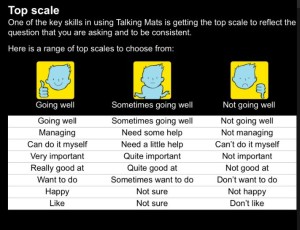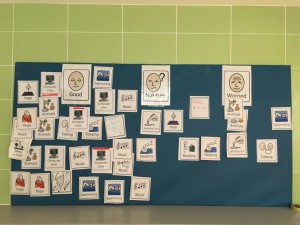Get involved in choosing a Communication Access UK Symbol , and set the standards to go with it!
In early 2017 Communication Matters[1] found out that –
- People with communication difficulties don’t always get the support they need in the community.
- People would like a Communication Access symbol in the UK. Businesses already use some symbols e.g
A small group of people were asked to choose a symbol to represent Communication Access. 2 ideas were very popular. For an organisation to display this communication symbol it will mean the staff have been trained to support communication and that the business meets certain standards
Communication Matters now want to hear from more people, with and without communication difficulties.
To have your say about 1) the symbol and 2) the standards to support communication follow this link. http://www.talkingmats.com/wp-content/uploads/2017/12/Communication-Access-UK-Symbols-and-Standards.pdf You will find the symbol choice and a Talking Mat to decide what is important to include in the Communication Access Standards. Send your responses to Communication Matters
Email : admin@communicationmatters.org.uk
Or post : Communication Matters, 3rd Floor, University House, University of Leeds, LEEDS, LS2 9DF
[1] http://www.communicationmatters.org.uk/
Do you need training to use Talking Mats ?
Talking Mats is an effective but deceptively simple tool so a question we are often asked is do you need training to use it. Communication and supporting people with communication difficulties is a complex process and Talking Mats is based on a number of research projects which examined who could use Talking Mats, and how best to use it in different situations. It is therefore important that the integrity of the Talking Mats model is maintained and that Talking Mats training teaches the principles developed from our evidence base.
All our trainers are registered with Talking Mats and provide high quality training based on robust research findings. Only trainers accredited by Talking Mats are eligible to train others.
Some of these principles include:
- Understanding who can and who cannot benefit from using Talking Mats
- Asking open questions
- Handing over control
- Pacing
- Maintaining neutrality
- Interpreting additional information including both non-verbal and verbal information
- Matching the top scale to the question or view being explored
- Presenting the options in an order that maximises the individuals ability to respond by using our model which focuses on concrete to abstract symbols
- Monitoring language complexity and topic sensitivity
All our training courses include hands-on practice and video examples as well as reflection on all these aspects of using Talking Mats
The techniques used in Talking Mats accord with best practice guidance in semi –structured interview techniques including:
- being clear in what you want to find out and using open questions
- enabling elaboration in whatever form is appropriate
- planning in advance but in a context that is flexible and can respond to the dynamics of the conversation
- being cognisant of the influence of the environment
- taking time to establish engagement and rapport
- being non-judgemental
- supportive of periods of silence
- ensuring there is a summary at the end so that both parties agree on what was said .
So whilst Talking Mats may seem simple, it is not simplistic. The listener is creating a space that enables the thinker to think and express themselves. Training gives the listener time to reflect on the components of an effective Talking Mats conversation and identify which ones they are already skilled in and which ones they need to develop further. There are no short cuts to reflective practice training and we know Talking Mats foundation training has impact. Time and time again people who thought they knew about Talking Mats reflect and say things like ‘I got so much more from this training than I expected’ or ‘ I now see I can use Talking Mats for so many different conversations not just ’ I like’ , ‘I don’t like’ ‘or ‘I have been using Talking Mats but now feel much more confident to use it and to make my own submats’

This is why we put so much emphasis on training. We have developed our successful “Train the trainer” scheme to ensure that quality is maintained and reflective practice maintained. If Talking Mats is passed by word of mouth then key aspects of the framework are missed and/or misinterpreted which in turn lessens its effectiveness and impact.
People who come on training are often excited, want to tell colleagues and share it with others. Demonstration and sharing is fine, but it is important to be aware of the difference between sharing and training.
Sharing can often be appropriate especially when there is a team of people supporting the person or parents are keen to see how it works. You can show someone how to use a Talking Mat about a specific conversation. We call this a ‘demonstrating model’. It is helpful to give the listener the words to say to go with it. That way you are enabling other colleagues or family members to have an effective but specific conversation only.
If they then want to use it for other conversations we would strongly recommend they go on to attend the training. Attending a foundation course will enable them:
- to get more out of the technique
- to understand more about their own communication
- to become creative in their use of Talking Mats whilst still adhering to the research principles
- to be able to create their own mats or explore a topic in more depth using submats
So do you need training to use Talking Mats ? The answer is a resounding yes . Training supports you to be an effective Talking Mats listener and get the most out of this versatile communication framework. So if you have not attended a course check out our course opportunities.
https://www.talkingmats.com/training/foundation/
There are a few myths around about Talking Mats. What does it do? – It supports communication and it doesn’t replace a person’s existing modes of communication, be that speech, signing, a symbol book, a voice output communication device or app. Talking Mats works alongside these modes to help people communicate even more effectively about a particular topic.
Some more myths busted! Click on the picture to make it clearer.
We are working with our colleagues at Strathcarron Hospice to develop a resource for Advance Care Planning which should be available early in 2018.
This poster illustrates how we are developing the resource:
2017 TM and Advance Care Planning
During the pilot phase our colleague Sally Boa (Head of Palliative Care Education, Research and Practice Development at Strathcarron Hospice) received the following moving story from Lorraine. We are extremely grateful to Lorraine for allowing us to publish it.
“My name is Lorraine and I am a carer for my husband who has cancer and is a palliative care patient.
I have been involved as a volunteer with Susan at Strathcarron Hospice since February this year. This was a group formed from the community put together by volunteers to get their help and opinions of thinking ahead and to understand what a loved one wants for their future and awareness of information and services available to people caring for someone with a long term illness/palliative care, but most importantly how best to get a loved one to open up and talk about their feelings and what they want for their future and arrangements.
Personally it has been for me interesting, draining and emotional at times, but this journey I have been on has made me think and realise that these are very important issues that need to be talked about with my husband and family.
I had tried to get Gordon to talk about these things, but it was difficult to bring the subject up. He just changed the subject. I tried leaving booklets lying on the table when I was out, but if he did look at them he never mentioned it.
Thinking about death is very emotional and stressful subject to talk to someone you love about. I know how I felt with these thoughts going round in my head and it was not nice. As for our two sons they seem to have accepted the situation now, although it was difficult. We have never lied to them and tried to explain what’s going on, but finding the right words isn’t easy. Moving to acceptance instead of denial is very, very hard on everyone.
I also have been involved with trying out Communication Cards (Talking Mats) which had been designed to help people who have difficulties in communicating. I went to the Hospice where I was asked some questions that I answered using the cards. I answered using the cards under the guidance of “feelings” I was surprised to find I had more positive replies than any of the others, I feel the cards would help people show their feeling better. I was asked if Gordon would be interested in doing the same. Sally emailed me a photo of my cards/answers, and I showed it to Gordon and I took the chance and asked him and he said yes. Sally came to the house and they did the task using the cards with no input from me {I kept very quiet ha ha}. The benefit Gordon got from this was really good. He was quite surprised to find he had placed more cards on the positive side as well his thoughts and feelings and he felt good about actually seeing that in front of him.
When Sally left I thought to myself this is my chance to approach the subject but again deep down I was scared as the last thing I wanted was to upset him.
I approached the subject with Gordon…. how about we continue chatting about what he wanted for his future and arrangements etc. I put it to him he knew what I was involved with for months with Susan and Mandy and that he was always interested to hear what we were doing but the truth was I still didn’t know what he wanted, I only knew he wanted a church service and burial. We sat at the table and talked about everything, I took notes what Gordon was telling me he wanted about everything.
I am an awful one for my Diary/ Journals I recorded everything we discussed finances, lawyer, wills, his wishes, Hymns he wanted, service at the graveside,what was to be given to family etc. in fact everything we could think of is now recorded and in one place. Both our boys will be told and where to find it. Jokingly to make it a bit light hearted I said I could go first you know, so we both took the opportunity to write and record all my wishes which is listed in the same journal.
Afterwards I really don’t know how to explain it but I felt a tonne weight off my shoulders, I now know everything I need to know.
More important for me I’ll never need to discuss it again with Gordon the book will be locked away safe and we can get on with our lives.
Please try and find the right time to talk, it’s very important and it will stop a lot of stress and emotional turmoil at what would be a very sad time for all.”
We are always very grateful for comments and suggestions about our resources, so have been listening to our customers and working to upgrade the Talking Mats Health and Well-being resource and the 4 digital resources.
There are several additions which apply to both the original and the digital versions of Health and Well-being.
- Originally we had asked our artist not to put clothes on the characters to try to make them culturally neutral but following a number of comments – (in particular the bare hairdresser who caused much amusement!) – our artist has added clothes on those symbols where the character was obviously naked.
- Next we have included additional relevant symbols and altered others to make the resource more comprehensive.
Our App developer has also been working to incorporate all of the above features into the digital version. He has included a more comprehensive list of wording for the top scale. (Click on the image to enlarge)
He has also added a feature which lets you toggle the wording for the top scale on and off; he has sorted the split words under the symbols and he has improved how the final record of the Talking Mats is displayed in the email sent.
Finally we are delighted to announce that our 4 main Talking Mats resources have been developed in German for the Digital version in collaboration with Professor Norina Lauer at the University of Idstein. All 4 resources – Health and Well-being, Children and Young People, Eating and Drinking and Social Care will all be available on the App by clicking on the German flag in the opening page.
The German version is not available in the original hard copy but you can order the resources with no words to allow you to add your own.
The upgrades to the digital will happen automatically in the next few weeks at no extra cost and if you would like the hard copy sets to upgrade your original resources, you can order them from us at a reduced cost. 2017-18 Additional Symbols Post Training Order form
Thanks again for your feedback – keep the comments coming!
Thanks to Rosie Murray for this great blog describing how she used a collaborative Talking Mats ‘Wall’ to help students comment on how different activities inside and outside college make them feel.
As a student, I trained in the Talking Mats approach, after finding it incredibly useful in clinical placements. I am now a speech and language therapist at St John’s College in Brighton. This is a college for young adults with autism, learning disabilities and SEBD. Our learners have a wide range of communicative needs and cognitive abilities. I was approached by our nursing team in the lead up to world mental health awareness day, as they were organising a ‘tea and talk’ session for our learners of all abilities.
We organised a range of activities, such as symbolised conversation starters. However, we felt we needed something to allow our less verbal learners to make their voices heard. I thought back to my training, and remembered Joan Murphy talking about large, collaborative Talking Mats – or ‘talking walls’. We discussed this idea, and felt it would be a great way for students to feedback on how different activities inside and outside college make them feel.
It took some considerable planning. Due to the emotional needs of some students, our top scale required us to avoid words that were too upsetting for individuals. In the end we settled on ‘good’ (with a widget ‘calm’ symbol) and ‘worried’. We also wanted it to provide a genuine opinion, so although we considered including activity options that were clearly negative, e.g. ‘fire alarms’, we took the opportunity to show our learners that we all have different opinions on things, and that this is good. We hypothesised that because of this, learners would be skewed towards giving positive opinions, and this informed the order of presentation of the top scale and the activities themselves.
On the day, we had 15 different activities to give an opinion on, each with different border colours for differentiation, and of course blank tiles so our learner’s could come with their own activities. Students were encouraged to write their name on the back of a chosen activity, and a consistent script was used to present the wall to each learner. Makaton signing was used alongside the script to support understanding.Learners of all abilities offered their opinion, and it generated discussion between learners of differing abilities. It signposted staff to particular likes and dislikes of learners, and showcased the power of talking mats to all staff. For example, one of our learners is a cheerful young man, who uses minimal verbal utterances to communicate. When the board was presented to him, he very clearly selected ‘talking’ as an activity, and clearly indicated that it makes him worried. This has allowed us to reflect as a staff team about how we can support him to communicate with minimal anxiety.
Learners too took away some important lessons from using the wall. They saw that while some activities are VERY popular (e.g. computer time), some are quite polarised, e.g. animals. This highlights the important issue of mutually respecting each others differences. Since the event, staff have discussed ideas they have on how to utilise this tool. We are considering how we could use Talking Mats as a tool in our peer mentoring sessions between learners of higher and lower verbal ability, as we feel it would be beneficial for both mentee and mentor. We are looking forward to using Talking Mats as a flexible tool for the college in the future.
Please let us know of any other innovative ways of using Talking Mats!
We have recently revised and updated our on-line Talking Mats foundation course . It now runs over 6 weeks and is designed to take an average of 12 hours of your time. Participants can go at the pace that suits them so for example in the last course one person completed in 2 weeks and another used the full 6 weeks .
The feedback has been really positive about lots of different aspect of this way of learning and included comments about
The structure of the course
‘It has been very well laid out, all modules flowed well together. There was a clear progression to build up our skills and the tutor offered really constructive feedback’
‘ ‘It was good to be able to do it in my own time – my work schedule became more hectic than I had anticipated but I was able to still do it in the evenings and weekends
’ The website was easy to use and useful to have the forum and see all the different uses of talking mats. This has inspired me to use the tool outwith work and within the voluntary sector.’
‘When I could not access my laptop I could access on my phone ‘
Knowledge and application of Talking Mats
‘This course has strengthened my knowledge about who, when and how to involve Talking Mats in my work’
‘Talking Mats has already allowed me to find out more about my clients’ needs.’
‘Using Talking Mats has resulted in enabling my client to explain her fears and has encouraged her to come into and access the dental department’
‘I have never experienced this kind of outcome before with a person , who has got severe comprehension and cognitive problems (Circle 2). I noticed, that doing the concrete submats made her more able to follow me in conversations talking about issues in circle 3, By handing over the control to the thinker, it is wonderful to be able to balance, and empower the conversation. That gives me satisfaction and joy.’
I’ve found the experience of actually using Talking Mats in practice immensely satisfying,. Each time it’s surprised me how engaged the thinker appears to become, and how readily their voice comes through when it has the space and time to do so’
‘ I wouldn’t hesitate now in using Talking Mats , even with people who have strong verbal skills if I felt it could be a useful way of getting them to focus on and think around a particular topic.’
Wider reflection on personal communication
‘My communication skills have benefited – this course has really encouraged me to think about phrasing, question types, clarity etc.’
‘It has led me to reflect on how complicated some of the things I ask of people are.’
‘I can evaluate whether communication is effective and how I can improve this.’
So if you want a course that you can do without travel and that enables you to
- Understand the Talking Mats communication framework- in particular who to use it with and for what topics and questions
- Be able to use Talking Mats for a range of purposes within your setting.
- Gain confidence in using tool based on best practice interview techniques and which evidences your commitment to person centred working
- Have increased awareness of your own communication style particularly interacting with people with communication difficulties.
If this is you book on our next course starts the 5th Dec
Further reading Check out Natalie Leader blog about her experience of completing the course from Tasmania
Talking Mats is a useful tool to help parents see their child’s point of view.
The stage for each parent when their child also has an opinion about what is best for them can come as a surprise and is sometimes challenging. For parents of children with disabilities it can be even more so. This story is an example of how Talking Mats helped parents hear their own child’s voice amongst the background noise of the voices from health, education social and voluntary services.
David was in his final year of primary school. He attended a small village school and was transitioning to a large mainstream secondary. He has mobility problems due to cerebral palsy and uses a wheelchair. He can walk very short distances with effort using a walker and in his primary school used this method to move around the classroom and go to the hall for lunch and PE. This was a functional way to meet 2 of his targets : changing position and walking practise. His parents wanted this to continue when he transitioned to secondary school, although the health professionals involved felt it was going to be too difficult given the greater distances in the new building. An electric wheelchair was proposed for this new context. David’s parents were finding this next step challenging.
One of the professionals involved wanted to find out what David felt was important in his new school and used Talking Mats as a way of supporting him to think about various factors. The top scale used was ‘important/ not sure/ not important’.
David’s mat clearly showed that what was important to him in his new school was being with his friends. When his parents saw his mat they realised that this would be impossible if he was to move from class to class using his walker and it helped them make the transition to seeing him in an electric wheelchair. It also helped them see things from David’s point of view. They were more than happy to fit walking practise into a different part of his busy day because they had heard what was important to him.
Talking Mats allows different voices to be seen and heard.The name has been changed to protect identity.
Talking Mats and Autism- Have you sometimes tried it and it didn’t work?
There is a growing interest in teaching TM to people with ASD. We know that some important adaptations might be required to make this a meaningful experience, and are keen to share our learning so far.
Being asked for thoughts or views can be difficult for some people with communication difficulties. In particular, there is a group of people with autism where some of the core principles of Talking Mats have to be taught in stages. Some thinkers will just ‘get it’ and find it a valuable tool for sharing their thoughts and for supporting decision making. For others there may have to be adaptations and /or specific teaching e.g. the vocabulary of the top scale. We heard recently of a student in a specialist centre who couldn’t use Talking Mats. However the staff would include him in groups where it was used and make sure he was around others doing Mats. After a few years, he did learn the principles and go on to use it effectively.
We have gathered ideas and knowledge from practitioners working in the field of autism and included these on our web-site under Free Stuff on Communication Disability. ASD guidelines It’s important that these guidelines grow and adapt as we learn more about using TM with an even wider range of people.
We’ve arranged a twilight session here at Stirling on the 1st of February 2018 to bring together practitioners working in the field of autism to extend our knowledge and encourage a staged approach to effective use of Talking Mats.
We’re delighted that Ruth Chalmers, Principal Teacher for Autism Spectrum Info and Support Team (ASIST) in Fife will be joining us to talk about developing social communication skills using Talking Mats. There will be time for small group chat so bring along a case you want to discuss.
Please share the attached flier 201802 AsD seminar with your network and we hope you can join us
Please come along and If you are interested in attending this twilight session 4.00pm to 6.00 pm (cost £20.00), please notify us at info@talkingmats.com
It’s not necessary to use every symbol in each topic set to have a successful conversation. The Talking Mats symbol sets have a range of options, some concrete and some abstract (more difficult for some to understand) You don’t need to use every symbol in your set!
People have found the Work/Education set in the Health and Wellbeing resource useful around times of transition from senior school or when finishing college. It is also valuable as a tool to support a person’s thinking during the process of applying for jobs. The symbols support these 2 aspects of work and education and are taken from the WHO ICF section on Major life areas[1]. For more information here’s a link to an earlier blog about the ICF. http://www.talkingmats.com/whats-health-well-resource/
When asking someone to think about different kinds of work, suggested top scales are like/not like or important/not important. The choice is dependent on what you want to find out and what level of understanding the thinker has.
If the person is then pursuing options, there are different symbols to cover the aspects involved in this. e.g. application and interview. A different top scale managing /not managing ensures useful information is gained.
Each topic set can be broken down into what matters to that person at that moment in time, and using different top scales results in getting different information.
This set is available to purchase in both digital form and symbol cards www.talkingmats.com
[1] ICF International Classification of Functioning, Disability and Health –World Health Organization p164-167
 Online training login
Online training login 










